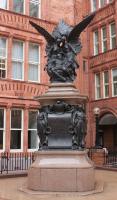
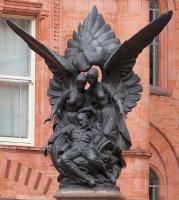
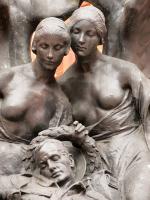
Prudential War Memorial, by Blundstone.
Prudential War Memorial, by Blundstone.


The most magnificent building along Holborn is J.W. Waterhouse’s Prudential Building, a massive Gothic pile in his favourite bright red terracotta, and in the courtyard of this building is an excellent monument, which is the Memorial to the Prudential men who fell in the Great War. It is one of the most perfect sculptural pieces of the period, in terms of the quality of the figure sculpture, the composition, and the sentiment, but by virtue of being under an arch and a few yards away, is unseen and probably unknown by most of the many passers-by.
The memorial centres on the collapsed figure of a soldier with a pair of angels above him. This stands on a square granite plinth, around the short column of which are scrolly panels with standing girls – figures of Victory – at the corners (for more angel statues, see this page; for more allegorical statues of Victory, see this page). The sculptor was F.V. Blundstone.
The bronze group of the soldier and angels is an inspired composition. The soldier sprawls, half seated, half lying, on the detritus of war, one arm thrown outwards over the wheel of some collapsed artillery piece, head resting sideways as if sleeping, his legs bent to one side to suggest arrested action. His helmet, behind his head, suggests a halo.
Above him are the pair of angels, as beautiful girls with uplifted wings, in the lightest drapes and bare-breasted. They hover above the soldier, their heads together, their faces sombre as befits the subject, giving a sentiment without sentimentality to the group. The youthful perfection of the angels contrasts with the careworn, lined face of the soldier, and equally his outstretched hand, rough, bony and hanging motionless, is contrasted with that of one of the angels a little above, smooth, lively and expressive. The open wings of the angels above, like the rest of the group, are balanced but not symmetrical. Standing a little away, the viewer can see that the group is based on two or three concentric diamond shapes, with the heads, bodies, limbs and wings as the points and sides.
Front panel of the Prudential memorial, and detail of the four Victory figures.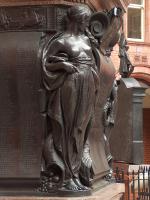
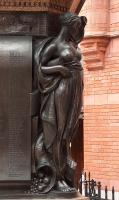
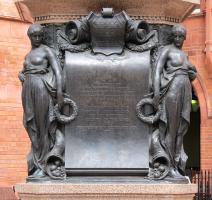
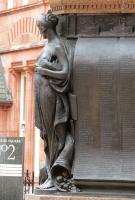
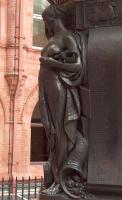
On the four sides of the plinth are scrolls, also in bronze, with the main inscription at the front, and listing the names of the fallen around the sides. The girls at each corner are very similar, but not identical. They stand, heads turned, lightly draped as the angels above, with long skirts below, diaphanous enough to emphasise the swell of thigh and calf, and their upper drapes somewhat heavier, but pulled down and back to leave shoulders and breasts uncovered. Each has at her feet a pair of cornucopias (horns of plenty), spilling out a harvest of fruit. Each holds in one hand a wreath, and in the other some different accoutrement – a small cannon, ship, etc. In the fashion of Blundstone, the sculptor, these girls are most beautiful in a pensive, art nouveau fashion, slender almost to the point of gauntness particularly about the shoulders, the sideways turn of each head serving to tauten and emphasise the muscle of the neck.
Also there is a World War II memorial, two bronze panels with above each, a miniature male figure of St George, in plate armour, holding aloft a flag on a tall pennant, and a wreath, and resting his other hand on his shield, which bears the cross (lots more figures of St George are on this page). He is bear headed, and rather youthful, with tightly cropped hair: despite the modelling of the face, this hairstyle on its own would suggest the post-WW2 date of the work, in fact 1950. Blundstone was again the sculptor.
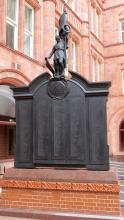
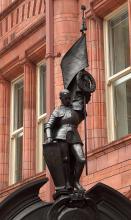 Prudential World War II memorial, by Blundstone.
Prudential World War II memorial, by Blundstone.
Ferdinand Victor Blundstone was the sculptor of several war memorials, including the Folkestone war memorial noted on this page, and also the Plimsoll memorial noted on this page. A separate small page here gives a little more information on him.
John William Waterhouse's Prudential Building, and terra cotta decorations.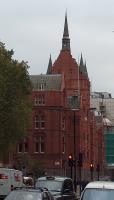
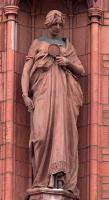
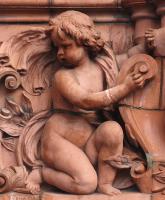
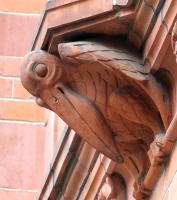
The Prudential Building itself, the unmistakeable work of the architect John William Waterhouse, most famous for St Pancras Station Hotel and for the Natural History Museum, is itself a fantastic building. The size is such that the other side of the road is too near to stand properly back from it, but the view along the road shows the spiky towers to good effect. There is a fair degree of minor architectural carving, including a figure of Prudentia herself (various other such things on this page), the allegorical girl who the Pru took as their symbol, and thin bands of decorative cherubs and shields in a repeating design, and smaller things, such as the charming pelican above forming a little corbel. And the cast gates are to be seen also, and include two roundels with low relief sculpture of semidraped kneeling figures, male and female (latter shown at bottom of this page).
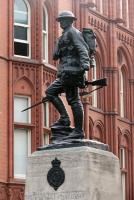 Royal Fusiliers Memorial, by Albert Toft.
Royal Fusiliers Memorial, by Albert Toft.
Just outside the building on the main road is a further war memorial: the Royal London Fusiliers Memorial, put up after World War I. On a tall plinth stands a statue of a soldier with bayoneted rifle. He stands with head turned, one foot raised and resting on a rock, as if he has just climbed to a vantage point to scan the horizon. It is a superior piece, so much better than the more recent military statues which, for example, are dotted around near the Ministry of Defence in Whitehall. This is the work of the New Sculptor Albert Toft, who made various war memorials, but is best known perhaps for his statues of beautiful allegorical girls, akin in spirit if not in style to the semi-nude figures of Blundstone we have been looking at.
This page was originally part of a 'sculpture of the month' series, for October 2015. Although the older pages in that series have been absorbed within the site, if you would wish to follow the original monthly series, then jump to the next month (Nov) or the previous month (Sept 2015). To continue, go to the bottom of each page where a paragraph like this one allows you to continue to follow the monthly links.
Nearby: East to St Sepulchre Church // or Prince Albert Statue, Holburn Circus // or Old Bailey // West to Kingsway // South to Fleet Street
London sculpture // Sculpture pages
Visits to this page from 1 Sept 2015: 7,066